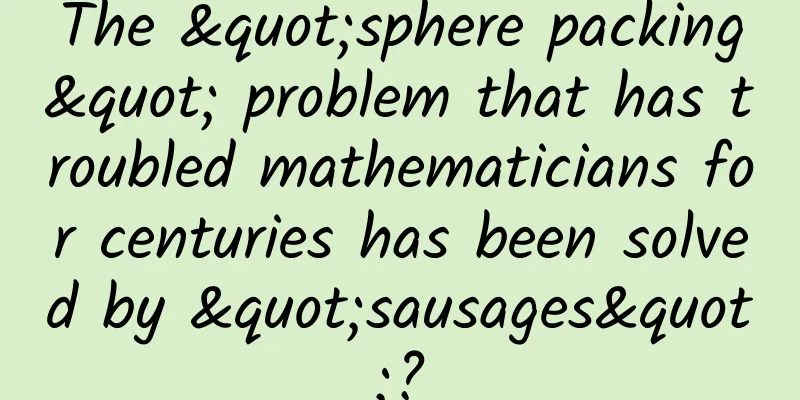The "sphere packing" problem that has troubled mathematicians for centuries has been solved by "sausages"?

|
Science and Technology Daily, Beijing, December 14 (Reporter Zhang Jiaxin) What is the most space-saving way to pack tennis balls or oranges? Mathematicians have been studying this "sphere packaging" problem for centuries. But few people pay attention to how this problem will work in the real world. Now, a physics experiment involving micro plastic balls at the University of Twente in the Netherlands has finally explained it clearly: for a small number of balls, it is best to pack them in sausage-shaped packaging. The relevant paper was published in the latest issue of Nature Communications. Johannes Kepler was the first to study sphere packing. He proposed in 1611 that a pyramid shape was the best way to pack cannonballs for long voyages, but it wasn't until 2014 that mathematicians fully confirmed the answer. However, the proof only considered the best way to arrange an infinite number of spheres. In addition, sphere packing theory assumes that the spheres are very hard and do not attract or repel each other, which is rarely the case in real life. For example, tennis balls or oranges will squeeze each other. What shape would be the most efficient for real-world finite sphere packing? Tiny polystyrene spheres are very rigid and essentially inert. The researchers experimented by inserting these spheres into empty cell membranes and were surprised to find that they arranged themselves into long, sausage-like strips. The research team decided to study and simulate different numbers of polystyrene balls in the bag. They compared the predictions with experiments using up to nine polystyrene balls squeezed into a cell membrane immersed in a liquid solution. They then shrink-wrapped the balls by changing the concentration of the solution, making the membrane tighter, and used a microscope to observe the formation of the balls. The researchers said that for up to nine spheres, both experiments and simulations proved that the sausage shape was the best packing shape. When there were more than nine spheres, the membrane would deform due to the pressure of the spheres. But when there were 56 to 70 spheres, the packing efficiency suddenly became efficient. These findings may have applications in drug delivery, such as how to most effectively pack hard antibiotic molecules inside cell membranes. |
<<: Role-playing? Big language models are just "scholars" without emotions!
>>: What does a doctor mean by "light diet"? I bet few people know
Recommend
Tips for editing content in public accounts (recommended for collection)
Don’t know where to start when creating a public ...
100 information flow rankings: Video leads the ranking and has the highest traffic growth!
Today I will share with you an APP heat index rep...
Releasing 25,000 catfish for blessing? 20,000 catfish died, fined 58,000 yuan!
Recently, the country's first civil public in...
Service Mesh Istio Basics and Practice
Introduction to the basics and practical resource...
Are couriers switching jobs to deliver takeout? Reporter survey: Job-hopping is not common
The poor management of the Yuantong Express Huayu...
Online event promotion, increased 100,000 users in seven days!
What kind of event can enable a beauty store to g...
Li Dongmin of Juefei Technology: Autonomous driving technology has entered the ecological era, and China's path is leading the world
In the past 2020, new energy vehicles that have s...
The world's first satellite successfully entered orbit!
The National Space Administration announced today...
Why is Samsung the only one still using stylus when there were so many of them on the street?
When it comes to mobile phone styluses, I believe...
New scientific discovery! A guide to the parasites of the "poison king" of bat flies
Produced by: Science Popularization China Author:...
How do educational training institutions expand their customer base and attract students for enrollment?
The terms customer acquisition, traffic generatio...
Lao Duan said: The Internetization of TV Brands
By chance, I invited my neighbor to dinner. Their...
What kind of content on Tik Tok is most likely to go viral? Tik Tok popular content categories
Today we are going to talk about what kind of con...
Goddess crash course: How to build your attractiveness? 12 series of lessons to teach you step by step
A beautiful appearance but a boring soul can only...
China Merchants New Intelligence and Juefei Technology reached a strategic cooperation to develop the digital economy and empower the construction of smart highways
With the release of the 14th Five-Year Plan and t...

![[Creative Cultivation Program] "King of Midnight Snacks" or "King of Destruction"? All about crayfish](/upload/images/67f2629fbf759.webp)







